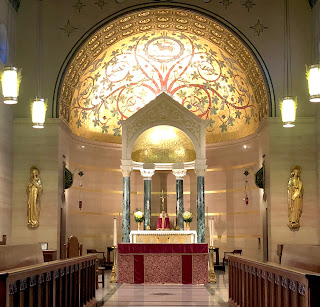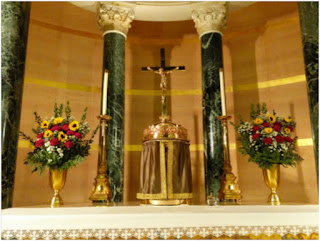Golgotha Revisited
Two life-size brass statues flank the sanctuary (bema) at the
chapel of St. Mary’s Seminary. Commissioned
in 1954, these statues represent the Blessed Virgin Mary and St. John the
Evangelist. Their images remind us that the altar represents the hill of
Golgotha in Jerusalem, so that every Eucharistic meal is not only a representation
of the Crucifixion, but that every Holy Communion allows participants to be
present, in both a metaphorical and real sense, during Christ’s sacrifice.
At first glance, these statues’ formal beauty may distract
us from the splendor of the message they proclaim. Why are these saints
given such a place of prestige, while the other gospel figures are not? The answer to this comes from the gospels, which describe the
Crucifixion of Jesus:
“…standing by the cross of Jesus
were his mother… When Jesus saw his mother, and the disciple whom he loved [John
the apostle] standing near, he said to his mother, “Woman, behold, your son!”
Then he said to the disciple, “Behold, your mother!” And from that hour the
disciple took her to his own home” (John 19:25-27, RSV).
This passage provides the last commandment that Jesus gave
before he died. Imagine Jesus, covered in blood and gasping for air, using this
particular moment to teach us more about his mission!
 Mary was present throughout Christ’s life from his birth and
ministry to his death. The young maiden who cradled the Christ Child in her
arms was also the widow who caressed the dead body of the God-Man—the scene
known today as the Pieta. In a world that persecuted, mocked, and
ultimately tortured Jesus to death, it was Mary alone who cared for him and
gave him true love (αγάπη) all
his life. In other words, Jesus’ experience here on earth was brutal and cruel;
the only consistent acceptance and comfort offered to him came from Mary. Jesus’ words to John “Behold, your
mother!” is a command that he has given to every believer. By centering our
gaze on Mary, we are focusing on the very Body of Christ—the Church, the Mater Ecclesiae.
Mary was present throughout Christ’s life from his birth and
ministry to his death. The young maiden who cradled the Christ Child in her
arms was also the widow who caressed the dead body of the God-Man—the scene
known today as the Pieta. In a world that persecuted, mocked, and
ultimately tortured Jesus to death, it was Mary alone who cared for him and
gave him true love (αγάπη) all
his life. In other words, Jesus’ experience here on earth was brutal and cruel;
the only consistent acceptance and comfort offered to him came from Mary. Jesus’ words to John “Behold, your
mother!” is a command that he has given to every believer. By centering our
gaze on Mary, we are focusing on the very Body of Christ—the Church, the Mater Ecclesiae.
It was only natural that at the end that Jesus made sure
that Mary would be cared for after he died, so he arranged her adoption by the
beloved disciple, John. According to tradition, John was the youngest of the
apostles and was cared for by Christ as if he was his younger brother; hence
why during the Last Supper, John rest’s his head on Jesus’ shoulder at the very
moment when Judas was announced as a betrayer (John 13:23).
 Like Mary, John was
at the foot of the cross until Christ’s death, when all the other apostles hid
from shame and fear—his loyalty has always inspired Christian devotion. It is not merely a coincidence that the
Pope’s Cathedral in Rome is dedicated to St. John and was the first church to
be built after Christianity was legalized by the Emperor Constantine in the
year 313.
Like Mary, John was
at the foot of the cross until Christ’s death, when all the other apostles hid
from shame and fear—his loyalty has always inspired Christian devotion. It is not merely a coincidence that the
Pope’s Cathedral in Rome is dedicated to St. John and was the first church to
be built after Christianity was legalized by the Emperor Constantine in the
year 313.
At St. Mary’s Seminary as we join with the priest in
offering the bread and the wine, the crucifixion and bloodshed of Christ on the
cross are made present to us. The sculptures of Mary and John remind us that we
are present with them, joining in the Holy Communion of saints which transcends
space and time. Every Catholic altar is Golgotha, just like every host and drop
of precious blood is the Body and Blood of the Risen Christ. These works of art
assist us in obeying Christ’s commandment: “Do this in remembrance of me”. We must always remember the atonement
for our sins and that our salvation came at a steep cost. As we contemplate the
Eucharist that we are digesting, we must sympathize with Mary’s and John’s
sorrow as they witnessed Our Lord dying for us.
Written by Charles A. Stewart, Ph. D. (Chair, Art History at University of St. Thomas)
www.charlesanthonystewart.com
www.charlesanthonystewart.com
For further reading on this topic:
- Pope Benedict XVI. Jesus of Nazareth. Volume 2: Holy Week. From the Entrance Into Jerusalem To The Resurrection (San Francisco: Ignatius), Pages: 219-222.
- Scott Hahn. Hail, Holy Queen: The Mother of God in the Word of God (New York: Double Day, 2006), pages 37-46.
- Timothy Verdon. Mary in Western Art (Rome: Filippo Rossi, 2005)



Comments
Post a Comment